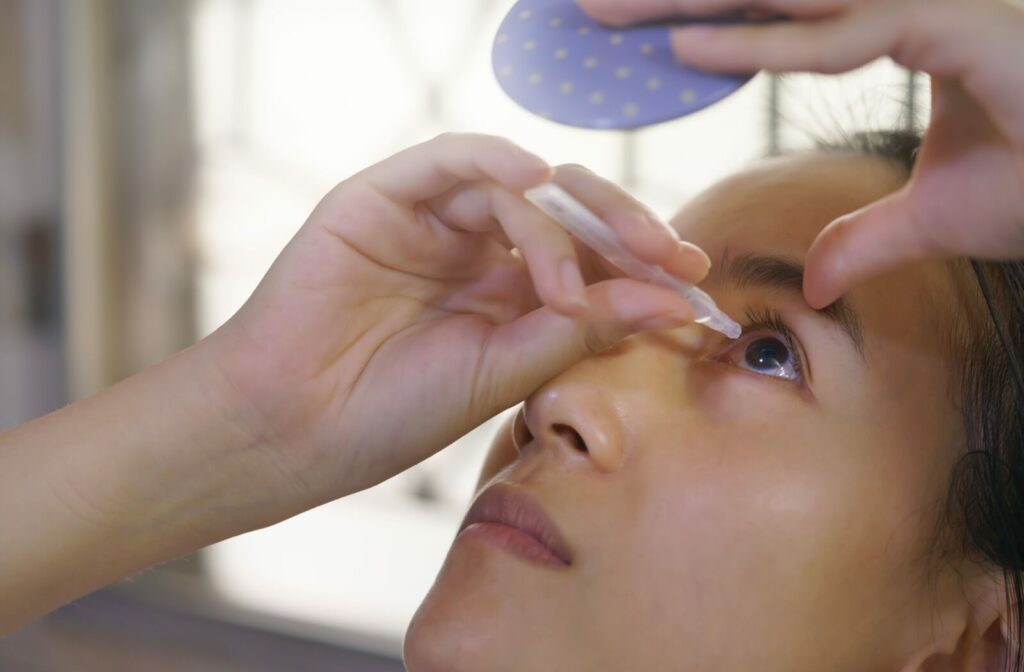If your eyes often feel dry or irritated and you notice blurry or fluctuating vision, you may be experiencing dry eye syndrome. While it’s easy to dismiss these symptoms as a minor discomfort, dry eyes can affect your quality of life, making daily tasks like reading, driving, or working on a computer more difficult. Left untreated, dry eye syndrome can lead to more serious eye health issues over time.
How Do Dry Eyes Cause Blurry Vision?
The surface of your eye, known as the cornea, relies on a stable tear film to help it focus light properly. This tear film of three layers—oily, watery, and mucous—is important in maintaining clear vision, comfort, and eye health.
When the tear film becomes unstable due to poor-quality tears or inadequate tear production, the light entering the eye scatters instead of focusing sharply. This disruption often causes fluctuations in vision, making it blurry, especially under certain conditions.
Situations That Worsen Dry Eye-Related Blurry Vision
Here are a few potential ways:
- Prolonged screen time: Staring at screens reduces your blink rate, causing tears to evaporate faster.
- Air-conditioned environments: Dry air can worsen dryness by speeding up tear evaporation.
- Contact lens wear: Lenses can interfere with your tear film, making dryness and blurry vision more noticeable.
By understanding these triggers, you can take steps to minimize their impact on your eyes.
Common Dry Eyes Causes
Dry eye syndrome can stem from a range of factors, including age, environment, lifestyle, and health conditions. Here are some of the most common causes:
Age & Hormonal Changes
Tear production naturally decreases as you age, particularly for women during menopause. Hormonal changes significantly impact tear gland function, making older adults more prone to dryness.
Environmental Conditions
Living or working in windy areas, or spaces with artificial air conditioning can cause tears to evaporate quickly, disrupting your tear film.
Environmental Conditions
Using screens for extended periods without breaks, wearing contact lenses for long durations, or not drinking enough water can lead to dry eye complications.
Underlying Health Conditions
Chronic illnesses like Sjögren’s syndrome or rheumatoid arthritis can lead to severe dry eye. Additionally, medications such as antihistamines, antidepressants, and diuretics may impact tear production.
If you’re experiencing persistent symptoms, scheduling a comprehensive eye exam is a good next step. A professional evaluation can determine the root cause of your dry eye and guide you toward the best treatment plan.

How to Treat Dry Eye & Relieve Blurry Vision
The good news? Dry eyes and blurry vision are manageable with an appropriate approach. Below are some treatment options:
Artificial Tears
Over-the-counter lubricating eye drops supplement your natural tears, providing quick and temporary relief for mild symptoms, especially those triggered by environmental factors like wind, smoke, or dry air conditions.
Prescription Medication
For long-term management, your optometrist may recommend prescription drops such as Restasis or Xiidra to stimulate tear production and reduce inflammation in the tear glands.
Hydrations & Nutrition
A diet rich in omega-3 fatty acids (found in foods like salmon, walnuts, and flaxseeds) can enhance tear quality. Staying well-hydrated also supports healthy tear production. Supplement options designed specifically for dry eyes are another option to consider.
Lifestyle Changes
- Follow the 20-20-20 rule during screen use—every 20 minutes, look at something 20 feet away for at least 20 seconds.
- Use a humidifier in dry indoor environments.
- Limit daily wear time for contact lenses to reduce eye strain.
Consult with your optometrist to find the right combination of treatments to ease your symptoms and improve your vision.
Proactive Measures to Prevent Dry Eye
Prevention is often as important as treatment when it comes to protecting your vision and comfort. Incorporate these strategies into your daily routine:
- Follow an eye-healthy workspace setup: Position computer monitors 20-24 inches away and slightly below eye level to reduce eye strain. Use an anti-glare screen if possible.
- Avoid air vents and fans: Direct airflow can dry out your eyes quickly, so try to avoid sitting directly in front of them.
- Wear wraparound glasses: When outdoors in dry, windy conditions, sunglasses can shield your tear film from environmental stressors.
- Drink water consistently throughout the day: Proper hydration supports effective tear production.
- Schedule regular eye exams: Staying on top of your eye health ensures early detection of any changes or concerns.
By being proactive and adopting healthy habits, you can help to minimize dry eye symptoms and maintain clearer, more comfortable vision.
Clearer Sight, Brighter Days
Dry eyes don’t have to keep you from living comfortably or seeing clearly. At Virginia Eyecare Clinic, we specialize in customized care plans to alleviate dryness and help restore clarity to your vision. Our high-tech solutions and friendly, knowledgeable team are there to provide thorough treatments and a welcoming environment.
Take the first step toward long-lasting relief—schedule an appointment with Virginia Eyecare Clinic today. Your eyes deserve it!


